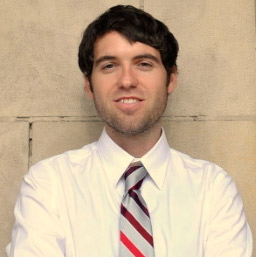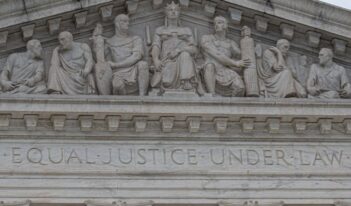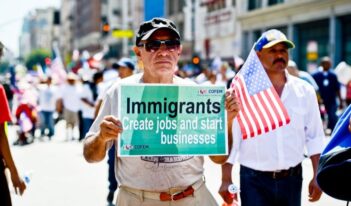
Far from being narrow, the U.S. Supreme Court’s latest LGBTQ+ decision may threaten government’s overall regulatory authority.
One of the most anticipated decisions of this Supreme Court term—Fulton v. City of Philadelphia—has surprised almost everyone. In a 9-0 decision handed down last Thursday, the Court proclaimed not even to “revisit” Employment Division v. Smith, a precedent that earlier this year appeared destined to be overturned. Smith has long stood for the proposition that individuals cannot simply claim a right to the free exercise of religion as an excuse for disobeying the law. But the Court nevertheless ruled for the religious claimants in Fulton on what appears at first glance to be a limited technicality—shades of Masterpiece Cakeshop from a few terms ago, where the Court accommodated religious objections to an antidiscrimination law but only on narrow, fact-specific grounds. To treat Fulton as a narrow case, though, may have it all wrong: the technicality the Court relies on may well be the whole ballgame.
In Fulton, the question before the Court was whether the City of Philadelphia could opt not to continue to work with Catholic Social Services because the organization refused as a matter of policy to make foster care placements with same-sex couples. The City Council argued that the organization’s policy violated the City’s anti-discrimination policies. Of course, Catholic Social Services had worked with the City for more than 50 years without ever encountering a same-sex couple seeking to provide foster care, so the religious organization never actually had denied a foster care placement to a same-sex couple. But the City decided nevertheless to refuse to keep working with the organization due to its policy against placements with same-sex couples. Catholic Social Services responded by going to court and arguing that the City had interfered with its right to free exercise of its religion.
Ever since 1990, the Court’s decision in Smith has been the leading precedent on the First Amendment’s Free Exercise Clause. As the Court in Fulton summed up, “Smith held that laws incidentally burdening religion are ordinarily not subject to strict scrutiny under the Free Exercise Clause so long as they are neutral and generally applicable.” Before Fulton was decided, the betting money seemed to be on the Court formally overturning Smith after having informally undercut it earlier this year in cases involving state COVID-19 restrictions that claimants argued had burdened their practice of religion.
The Fulton Court did rule in favor of Catholic Social Services. But instead of overturning Smith, the Court said that Philadelphia’s anti-discrimination policies did not constitute generally applicable law. Why not? Because, in the Court’s words, the City’s standard foster care contract incorporated a “system of individual exemptions, made available in this case at the ‘sole discretion of the Commissioner.’” The City’s refusal to grant an exemption under this provision effectively put the burden on the City to justify not using it to accommodate religion.
Even more, it did not matter to the Court that the Commissioner had never actually used this exemption provision: “The creation of a formal mechanism for granting exceptions renders a policy not generally applicable, regardless whether any exceptions have been given, because it ‘invites’ the government to decide which reasons for not complying with the policy are worthy of solicitude—here, at the Commissioner’s ‘sole discretion.’” Because the City’s anti-discrimination policy was potentially dispensable through case-by-case exemptions when religious parties objected, the City’s refusal to grant Catholic Social Services that exemption was subject to strict scrutiny. And as Court watchers know, strict scrutiny almost always means that the government loses.
The early reaction to the Court’s opinion in Fulton has focused on its apparent narrowness. As David Cole, the National Legal Director at the American Civil Liberties Union put it on Twitter, “ADF and others have long sought a First Amendment license to discriminate. They didn’t get it in Masterpiece. And now they didn’t get it in Fulton. Instead, in both cases, the Court reached narrow, fact-specific decisions that leave nondiscrimination mandates standing.”
Anti-discrimination advocate Chase Strangio likewise weighed in on social media, noting that “in Fulton, the outcome was 9-0 but the reasoning was all over the place. The majority reasoning was very narrow and fact-specific.” And attorney Ian Millhiser, who covers the Supreme Court for Vox, declared that the decision was a “small loss for the LGBTQ community in Philadelphia” but “the Court’s decision is unlikely to have many implications outside of that city.”
That the more liberal Justices joined the majority may indicate that they too believed that the opinion’s focus on possible exceptions was unlikely to do much damage to the government’s interest in enforcing generally applicable laws.
But some of the Justices may not have realized the full implications of the Fulton opinion’s logic, perhaps thinking that provisions explicitly authorizing exceptions to otherwise seemingly general rules are themselves rather exceptional. That way of thinking seems the only way to square the Court’s reasoning on the issue of general applicability with its statement that it was not revisiting its decision in Smith. But based on an empirical study we recently completed––along with our colleague Gabriel Scheffler at the University of Miami Law School––we see such explicit provisions as far from exceptional.
In our study, we used computers to analyze multiple sources of federal law, looking for provisions that allow for exceptions and other forms of what we called “unrules”—so named because such provisions provide a way of undoing the obligations ordinarily imposed by law. These unrules can sometimes be baked into the law itself, as with, for example, grandfathering provisions. But they can also take the form of authorizing administrative officials to grant dispensations—that is, to alleviate obligations on a case-by-case basis, much like with the Philadelphia contract at issue in Fulton.
Consider, for example, a catchall provision in the Federal Communication Commission’s (FCC) regulations that states that they “may be suspended, revoked, amended, or waived for good cause shown, in whole or in part, at any time by the Commission”—either on the Commission’s “own motion or on petition.” Does the existence of this unrule mean that no regulation issued by the FCC can be considered to be a law of general applicability and thus anyone with religious objections can escape from complying with FCC rules?
These sorts of unrules are rife throughout the law. We found at least one word in the U.S. Code and in the Code of Federal Regulations of the kind that alleviate obligations (such as “except,” “exempt,” and “waive”) for about every six words of the kind that impose legal obligations (such as “must” and “shall”). When we looked at all of the most significant regulations issued by federal agencies from 1982 to 2016, we found that 97 percent of these rules contained at least one obligation-alleviating word. One of these regulations even contained over 750 such words.
Although our effort to quantify the extent of provisions authorizing obligation alleviation was novel, we are hardly the first to acknowledge the ubiquity of exceptions in the law. Twenty-five years ago, for example, legal scholar Cass Sunstein observed that it is “familiar to find rules that have explicit or implicit exceptions for cases of necessity or emergency” and “unfamiliar to find rules without any such exceptions.”
Even when exemption authorizations are not explicit, another Supreme Court decision, in a 1985 case called Heckler v. Chaney, has made clear that agencies possess virtually unfettered discretion not to enforce the law. When an agency uses this discretion and passes up on enforcing the law against certain individuals or entities, it effectively grants them exemptions. Under Fulton, will agencies seeking to enforce regulations now have to meet a strict scrutiny test to justify why they did not use their Chaney discretion to decline to enforce the law against those with religious objections?
In relying in Fulton on the existence of a provision authorizing exemptions, the Supreme Court would seem to have opened the barn door for anyone with religious objections to escape from their duty to obey vast swaths of the law. Under the Fulton Court’s logic, few laws would appear to be laws of general applicability, as the possibility of exemptions are legion.
The Court’s more liberal Justices, in signing onto Fulton, may have unwittingly enabled the Court to expand what legal scholar Liz Sepper calls “Free Exercise Lochnerism”—that is, the systematic scaling back of the government’s regulatory authority under the guise of protecting First Amendment religious rights. As a result, courthouses across the country may now see an increase in defenses based on free-exercise claims, and officials at all levels of government may feel pressure to grant religious exemptions lest they face costly litigation.
From a practical standpoint, it surely seems as if Smith has been overturned. Fulton may turn out to be far from the narrow nothingburger that it has been portrayed to be.





